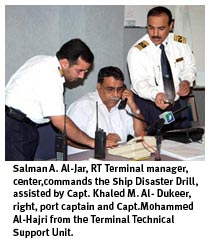Offshore Drill Finds Company
Posted: 01 August 2005
 Send this article Send this article
In order to test crucial emergency-response systems, Saudi Aramco recently coordinated a complex disaster drill at Ju'aymah offshore terminal, simulating an explosion, fire and oil spill that involved the Vela tanker Carina Star.
Capt. Khaled M. Al-Dukeer, port captain, said that in order to make the most of the training and testing opportunity, the Terminal Harbor Pilots Team made sure that the scenario was realistic and challenging.
The scenario began with a fishing boat colliding with the Carina Star,  causing an explosion that led to a fire and oil spill. The resulting oil spill, according to the scenario, was about 6,000 barrels, categorizing it as major. The simulated oil slick then followed the water's current toward shore, threatening not only recreational beaches, but also the Ras Tanura Refinery water intake. causing an explosion that led to a fire and oil spill. The resulting oil spill, according to the scenario, was about 6,000 barrels, categorizing it as major. The simulated oil slick then followed the water's current toward shore, threatening not only recreational beaches, but also the Ras Tanura Refinery water intake.
The multi-faceted drill was designed to trigger several emergency-response plans, requiring the involvement of many company organizations. Saudi Aramco emergency-responders also coordinated closely with government agencies on security and other matters during the drill.
As part of the drill, the various participants successfully tested the Terminal Ship Disaster Plan, Vela's Ship Disaster Plan, Oil Spill Response Plan, Oil Spill Clean-up activities and the approved Port Security Plan, which is part of the International Ship and Port Security Code (ISPS).
The ISPS relates to the security of ships and immediate ship/port interface, and is mandated by the International Maritime Organization.
Because of the size and scope of the scenario, the drill involved mobilizing significant company assets, including two helicopters, two air tractors and 11 marine vessels for fire extinguishing, rescue operations, removal of the Carina Star from the berth to a safe area, and oil spill clean-up activities.
In addition, the Ras Tanura Disaster Control Center was activated and connected to the Vela Incident Room in Dubai , allowing both centers to remain in close contact as they handled the many aspects of the simulated emergency. Oil booms, skimmers and other pollution-prevention equipment were deployed to protect environmentally and operationally sensitive areas in the Ras Tanura area.
Salman A. Al-Jar, manager of the RT Terminal Department, said that the drill was an unqualified success. "The purpose of these drills is to see what works and what doesn't," he said.
"Although we discovered that virtually all of our systems work extremely well, I believe that even our list of 'areas for improvement' is an indicator of the drill's success," he said. "As a learning organization, we strive to never make the same mistake twice, and I'm glad to see all of these company organizations learning together and improving, no matter how difficult the scenario."
Al-Dukeer added that this drill tested and enhanced Saudi Aramco ports' readiness in dealing with ship disasters, combating oil spills and improving communication with various company organizations.

Posted by Editor Pipeline Magazine
Replication or redistribution in whole or in part is expressly prohibited without the prior written consent of Reflex Publishing ME FZ LLC.
Send press release to info@pipelinedubai.com |



